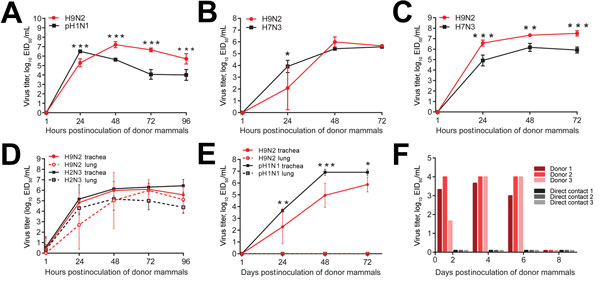Volume 21, Number 12—December 2015
Dispatch
Replication Capacity of Avian Influenza A(H9N2) Virus in Pet Birds and Mammals, Bangladesh
Figure 2

Figure 2. Pathogenesis of influenza A(H9N2) virus isolate A/environment/Bangladesh/9306/2010 (Env/9306) in ex vivo and in vivo mammalian models, Bangladesh. Replication kinetics of Env/9306 or a virus control are shown in A) primary normal human bronchial epithelial cells, B) primary human corneal epithelial cells, C) primary human trabecular meshwork cells, D) swine respiratory tissue explants, and E) ferret respiratory tissue explants. Error bars indicate mean + SD of the combined results of 2 individual experiments of n = 3 inserts, wells, or tissue explants per virus group. Env/9036 replication is indicated in red, and control virus replication in black. F) Replication of Env/9306 in ferrets (n = 3; red bars) and transmission to naïve, direct contact ferrets (n = 3; black bars) housed in the same cage. Statistical significance of replication between virus groups at a given time point was determined by performing a 2-way analysis of variance. *p≤0.05; **p≤0.01; ***p≤0.0001. EID50, 50% egg infectious doses.
Reference has only first page number. Please provide the last page number if article is longer than one page. (in reference 14 "Kageyama, Fujisaki, Takashita, Xu, Yamada, Uchida, et al., 2013").